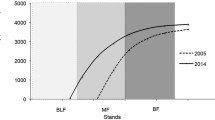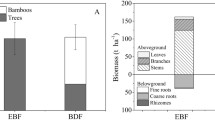Abstract
Aims
Moso bamboo (Phyllostachys pubescens) is a typical native invasive plant imposing serious threats on ecosystem processes and functions. A primary concern is alterations of litter and soil N mineralization in evergreen broadleaved forests coupled with bamboo population expansion.
Methods
We conducted a field study to determine the litter production, quality, N resorption efficiency, and soil N mineralization rates in bamboo-dominated forest (BDF) and adjacent uninvaded evergreen broadleaved forest (EBF) in subtropical China.
Results
The mean annual litter production for BDF was 5.82 Mg ha−1, 36.0 % lower than that for EBF (9.09 Mg ha−1). Litter N concentration was also lower, but C: N was higher after bamboo expansion, coupled with higher N resorption efficiency for Moso bamboo and lower litterfall, resulting in potential N return decreasing as much as 60.41 kg N ha−1 yr−1 to the soil. The soil N net nitrification and mineralization rates exhibited lower values in BDF than in EBF. In addition, annual soil N mineralization rate was positively correlated with litter production but negatively with C: N ratio of litter.
Conclusions
Expansion of bamboo into neighboring EBF decreased litter production and quality, reduced soil N mineralization rate, and ultimately retarded N cycling. These effects should be carefully considered in the design of restoration strategies for ecosystems impacted by bamboo species.



Similar content being viewed by others
Abbreviations
- BDF:
-
Bamboo-dominated forest
- C. fargesii :
-
Castanopsis fargesii
- C. sclerophylla :
-
Castanopsis sclerophylla
- EBF:
-
Evergreen broadleaved forest
- P. pubescens :
-
Phyllostachys pubescens
- Q. chenii :
-
Quercus chenii
- S. laurina :
-
Symploco slaurina
References
Aciego Pietri JC, Brookes PC (2008) Nitrogen mineralisation along a pH gradient of a silty loam UK soil. Soil Biol Biochem 40:797–802
Aerts R (1997) Nitrogen partitioning between resorption and decomposition pathways: a trade-off between nitrogen use efficiency and litter decomposibility? Oikos 80(3):603–606
Allison SD, Vitousek PM (2004) Rapid nutrient cycling in leaf litter from invasive plants in Hawai'i. Oecol 141:612–619
Ashton IW, Hyatt LA, Howe KM, Gurevitch J, Lerdau MT (2005) Invasive species accelerate decomposition and litter nitrogen loss in a mixed deciduous forest. Ecol Appl 15(4):1263–1272
Bai SB, Zhou GM, Wang YX, Liang QQ, Chen J, Cheng YY, Shen R (2013) Plant species diversity and its dynamics in forests invaded by moso bamboo (Phyllostachys edulis). Biodivers Sci 21(3):1–8(in Chinese with an English abstract)
Baker AC, Murray BR (2012) Seasonal intrusion of litterfall from non-native pine plantations into surrounding native woodland: implications for management of an invasive plantation species. For Ecol Manag 277:25–37
Berendse F (1990) Organic matter accumulation and nitrogen mineralization during secondary succession in heathland ecosystems. J Ecol 78:413–427
Berendse F, Lammerts E, Olff H (1998) Soil organic matter accumulation and its implications for nitrogen mineralization and plant species composition during succession in coastal dune slacks. Plant Ecol 137(1):71–78
Binkley D, Hart LSC (1989) The component of nitrogen availability assessment in forest soil. Adv Soil Sci 19:57–l12
Brantley ST, Young DR (2008) Shifts in litterfall and dominant nitrogen sources after expansion of shrub thickets. Oecologia 155(2):337–345
Ding LX, Wang Z, Zhou GM, Du QZ (2006) Monitoring Phyllostachys pubescens stands expansion in National Nature Reserve of mountain tianmu by remote sensing. Journal of Zhejiang Forestry College 23(3):297–300(in Chinese with an English abstract)
Ehrenfeld JG (2010) Ecosystem consequences of biological invasions. Annu Rev Ecol Evol Syst 41:59–80
Evans RD, Rimer R, Sperry L, Belnap J (2001) Exotic plant invasion alters nitrogen dynamics in an arid grassland. Ecol Appl 11(5):1301–1310
Fukushima K, Usui N, Ogawa R, Tokuchi N (2015) Impacts of moso bamboo (Phyllostachys pubescens) invasion on dry matter and carbon and nitrogen stocks in a broad-leaved secondary forest located in Kyoto, Western Japan. Plant Spec Biol 30:81–95
Isagi Y, Kawahara T, Kamo K, Ito H (1997) Net production and carbon cycling in a bamboo Phyllostachys pubescens stand. Plant Ecol 130(1):41–52
Isagi Y, Torii A (1998) Range expansion and its mechanisms in a naturalized bamboo species, Phyllostachys pubescens, in Japan. J Sustain for 6:127–141
Killingbeck KT (1996) Nutrients in senesced leaves: keys to the search for potential resorption and resorption proficiency. Ecol 77(6):1716–1727
King HGC, Heath G (1967) The chemical analysis of small samples of leaf material and the relationship between the disappearance and composition of leaves. Pedobiologia 7:192–197
Kurokawa H, Peltzer DA, Wardle DA (2010) Plant traits, leaf palatability and litter decomposability for co-occurring woody species differing in invasion status and nitrogen fixation ability. Func Ecol 24(3):513–523
Larpkern P, Moe S, Totland Ø (2011) Bamboo dominance reduces tree regeneration in a disturbed tropical forest. Oecol 165(1):161–168
Li R, Werger MJA, During HJ, Zhong ZC (1998) Biennial variation in production of new shoots in groves of the giant bamboo Phyllostachys pubescens in Sichuan, China. Plant Ecol 135:103–112
Li R, Werger MJA, Hd K, During HJ, Zhong ZC (2000) Interactions between shoot age structure, nutrient availability and physiological integration in the giant bamboo Phyllostachys pubescens. Plant Biol 2:437–446
Li XC, Meng FQ, Li MH, Yang DM (2014) Leaf fall patterns of 12 evergreen woody species in subtropical evergreen forest in Tiantong Mountain of Zhejiang Province, China. Bull Bot Res 34(6):741–750(in Chinese with an English abstract)
Liao C, Peng R, Luo Y, Zhou X, Wu X, Fang C, Chen J, Li B (2008) Altered ecosystem carbon and nitrogen cycles by plant invasion: a meta-analysis. New Phytol 177(3):706–714
Lin YT, Tang SL, Pai CW, Whitman WB, Coleman DC, Chiu CY (2014) Changes in the soil bacterial communities in a cedar plantation invaded by moso bamboo. Microb Ecol 67:421–429
Lindsay EA, French K (2005) Litterfall and nitrogen cycling following invasion by Chrysanthemoides monilifera ssp. rotundata in coastal Australia. J Appl Ecol 42:556–566
Liu J, Yang QP, Yu DK, Song QN, Zhao GD, Wang B (2013) Contribution of fine root to soil nutrient heterogeneity at two sides of the bamboo and broad-leaved forest interface. J Plant Ecol 37(8):739–749(in Chinese with an English abstract)
Liu W, Fox JE, Xu Z (2000) Leaf litter decomposition of canopy trees, bamboo and moss in a montane moist evergreen broad-leaved forest on Ailao Mountain, Yunnan, south-West China. Ecol Res 15(4):435–447
Nelson DW, Sommers LE (1982) Total carbon, OC, and organic matter. In: Page AL, Miller RH, Keeney DR (eds) Methods of soil analysis, part 2. Agronomy Society of America and Soil Science Society of America, Madison, WI, pp. 539–577
Nelson DW, Sommers LF (1975) A rapid and accurate method for estimating organic carbon in soil. Proc Indiana Acad Sci 84:456–462
Nugroho RA, Röling WFM, Laverman AM, Verhoef HA (2007) Low nitrification rates in acid scots pine forest soils are due to pH-related factors. Microb Ecol 53(1):89–97
Okutomi K, Shinoda S, Fukuda H (1996) Causal analysis of the invasion of broad-leaved forest by bamboo in Japan. J Veg Sci 7:723–728
Scott DA, Proctor J, Thompson J (1992) Ecological studies on a lowland evergreen rain forest on Maracá Island. Roraima Brazil II Litter and Nutrient Cycling J Ecol 80:705–717
Schulze ED, Beck E, Müller-Hohenstein K (2006) Plant ecology. Springer, Berlin
Shinohara Y, Otsuki K (2015) Comparisons of soil-water content between a moso bamboo (Phyllostachys pubescens) forest and an evergreen broadleaved forest in Western Japan. Plant Spec Biol 30(2):96–103
Song QN, Yang QP, Liu J, Yu DK, Fang K, Xu P, He YJ (2013) Effects of Phyllostachys edulis expansion on soil nitrogen mineralization and its availability in evergreen broadleaf forest. Chin J Appl Ecol 24(2):338–344(in Chinese with an English abstract)
Sundarapandian SM, Swamy PS (1999) Litter production and leaf-litter decomposition of selected tree species in tropical forests at kodayar in the Western Ghats, India. For Ecol Manag 123:231–244
Tong C, Zhang L, Wang W, Gauci V, Marrs R, Liu B, Jia R, Zeng C (2011) Contrasting nutrient stocks and litter decomposition in stands of native and invasive species in a sub-tropical estuarine marsh. Environ Res 111(7):909–916
Touyama Y, Yamamoto T, Nakagoshi N (1998) Myrmecofaunal change with bamboo invasion into broadleaf forests. J for Res 3:155–159
Tripathi S, Sumida A, Shibata H, Ono K, Uemura S, Kodama Y, Hara T (2006) Leaf litterfall and decomposition of different above-and belowground parts of birch (Betula ermanii) trees and dwarf bamboo (Sasa kurilensis) shrubs in a young secondary forest in Northern Japan. Biol Fert Soils 43(2):237–246
Tu LH, Hu HL, Hu TX, Zhang J, Li XW, Liu L, Xiao YL, Chen G, Li RH (2014) Litterfall, litter decomposition, and nutrient dynamics in two subtropical bamboo plantations of China. Pedosphere 24(1):84–97
Van Kleunen M, Weber E, Fischer M (2010) A meta-analysis of trait differences between invasive and non-invasive plant species. Ecol Lett 13(2):235–245
Wang B, Li HJ, Guo Q (2005) Study of forest biodiversity in Dagang Mountain, Jiangxi Province. China Forestry Publishing House, Beijing(in Chinese)
Wang QK, Wang SL, Xu GB, Fan B (2010) Conversion of secondary broadleaved forest into Chinese fir plantation alters litter production and potential nutrient returns. Plant Ecol 209:269–278
Watanabe T, Fukuzawa K, Shibata H (2013) Temporal changes in litterfall, litter decomposition and their chemical composition in sasa dwarf bamboo in a natural forest ecosystem of Northern Japan. J for Res 18(2):129–138
Williams RJ, Hallgren SW, Wilson GWT, Palmer MW (2013) Juniperus virginiana encroachment into upland oak forests alters arbuscular mycorrhizal abundance and litter chemistry. Appl Soil Ecol 65:23–30
Wu JS, Jiang PK, Wang ZL (2008) The effects of Phyllostachys pubescens expansion on soil fertility in National Nature Reserve of mountain tianmu. Acta Agric Jiangxi 30(4):689–692(in Chinese with an English abstract)
Yan ER, Wang XH, Guo M, Zhong Q, Zhou W, Li YF (2009) Temporal patterns of net soil N mineralization and nitrification through secondary succession in the subtropical forests of Eastern China. Plant Soil 320(1):181–194
Yan ER, Wang XH, Huang JJ, Li GY, Zhou W (2008) Decline of soil nitrogen mineralization and nitrification during forest conversion of evergreen broad-leaved forest to plantations in the subtropical area of Eastern China. Biogeochemistry 89(2):239–251
Yang QP, Wang B, Guo QR, Zhao GD, Fang K, Liu YQ (2011) Effects of Phyllostachys edulis expansion on carbon storage of evergreen broad-leaved forest in Dagangshan Mountain, Jiangxi. Acta Agric Jiangxi 33(3):529–536(in Chinese with an English abstract)
Yang QP, Yang GY, Song QN, Shi JM, Ouyang M, Qi HY, Fang XM (2015) Ecological studies on bamboo expansion: process, consequence and mechanism. J Plant Ecol 39(1):110–124(in Chinese with an English abstract)
Yang YS, Guo JF, Chen GS, Xie JS, Cai LP, Lin P (2004) Litterfall, nutrient return, and leaf-litter decomposition in four plantations compared with a natural forest in subtropical China. Ann for Sci 61:465–476
Yang YS, Guo JF, Chen GS, Xie JS, Gao R, Li Z, Jin Z (2005) Litter production, seasonal pattern and nutrient return in seven natural forests compared with a plantation in Southern China. Forestry 78(4):403–415
Yi TP, Shi JY, Ma LS, Wang HT, Yang L (2008) Bamboo altas of China. Science Press, Beijing(in Chinese)
Zhang K, Cheng X, Dang H, Ye C, Zhang Y, Zhang Q (2013) Linking litter production, quality and decomposition to vegetation succession following agricultural abandonment. Soil Biol Biochem 57:803–813
Acknowledgments
We are grateful to the Dagang Mountain National Forest Ecological Station for providing the study sites. We also thank to Rong Wu, Chun-ling Long, Yu-juan He, Pei Xu and Ying-ying Chen for their help with field and laboratory work, two anonymous reviewers and Dr. Chao Wang for their valuable comments and thoughts which greatly improving the manuscript. This study was supported by the National Natural Science Foundation of China (31260120 and 31460077) and Jiangxi Provincial Natural Science Foundation (20122BAB20401).
Author information
Authors and Affiliations
Corresponding author
Additional information
Responsible Editor: Klaus Butterbach-Bahl.
Rights and permissions
About this article
Cite this article
Song, Qn., Ouyang, M., Yang, Qp. et al. Degradation of litter quality and decline of soil nitrogen mineralization after moso bamboo (Phyllostachys pubscens) expansion to neighboring broadleaved forest in subtropical China. Plant Soil 404, 113–124 (2016). https://doi.org/10.1007/s11104-016-2835-z
Received:
Accepted:
Published:
Issue Date:
DOI: https://doi.org/10.1007/s11104-016-2835-z




